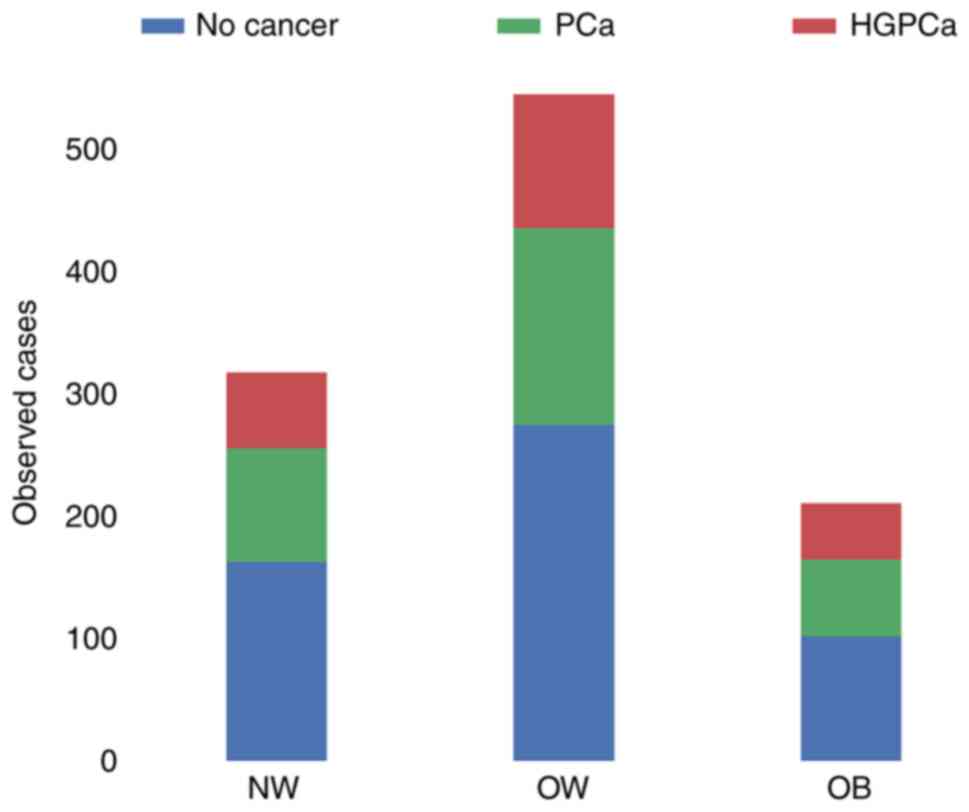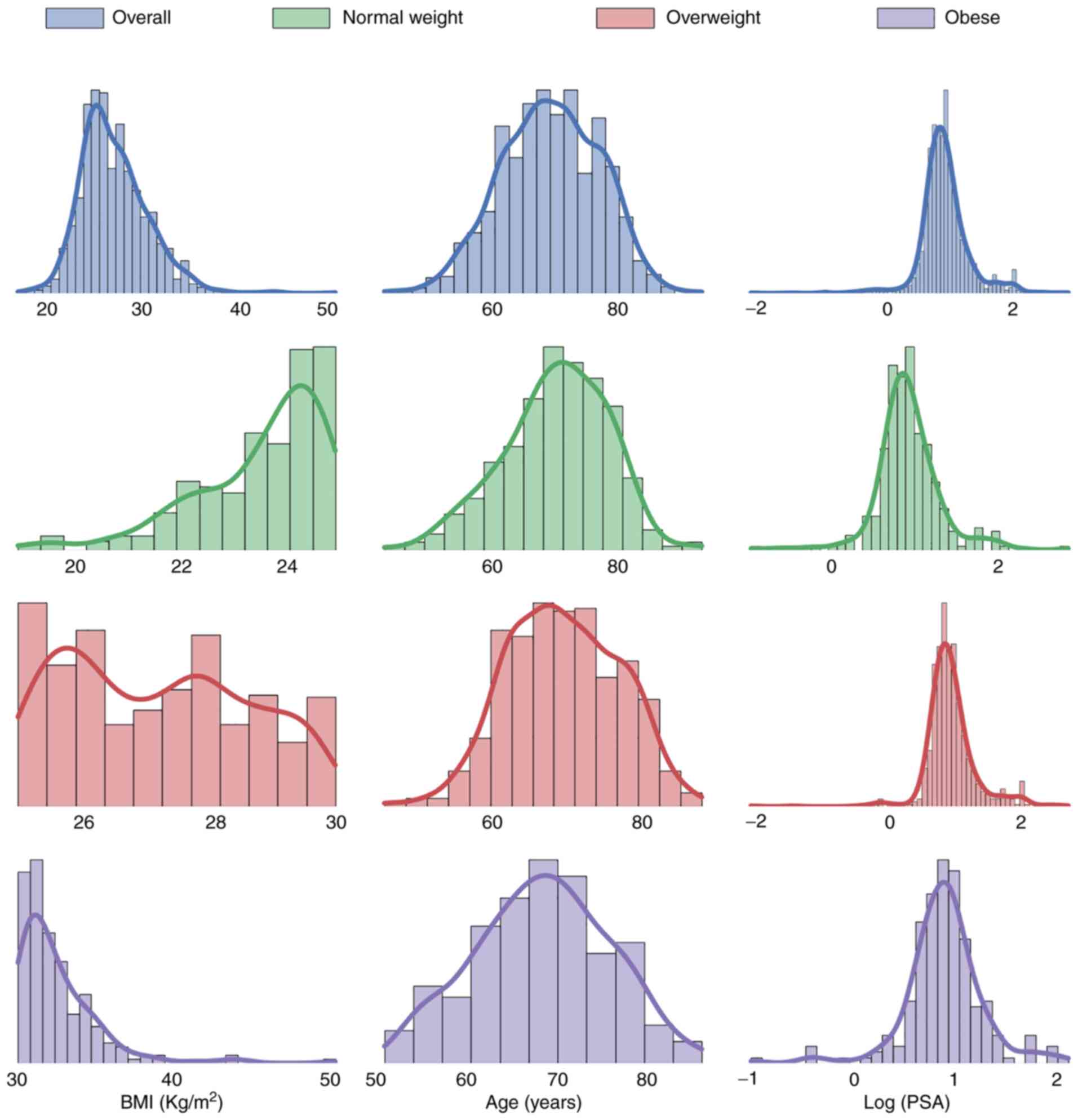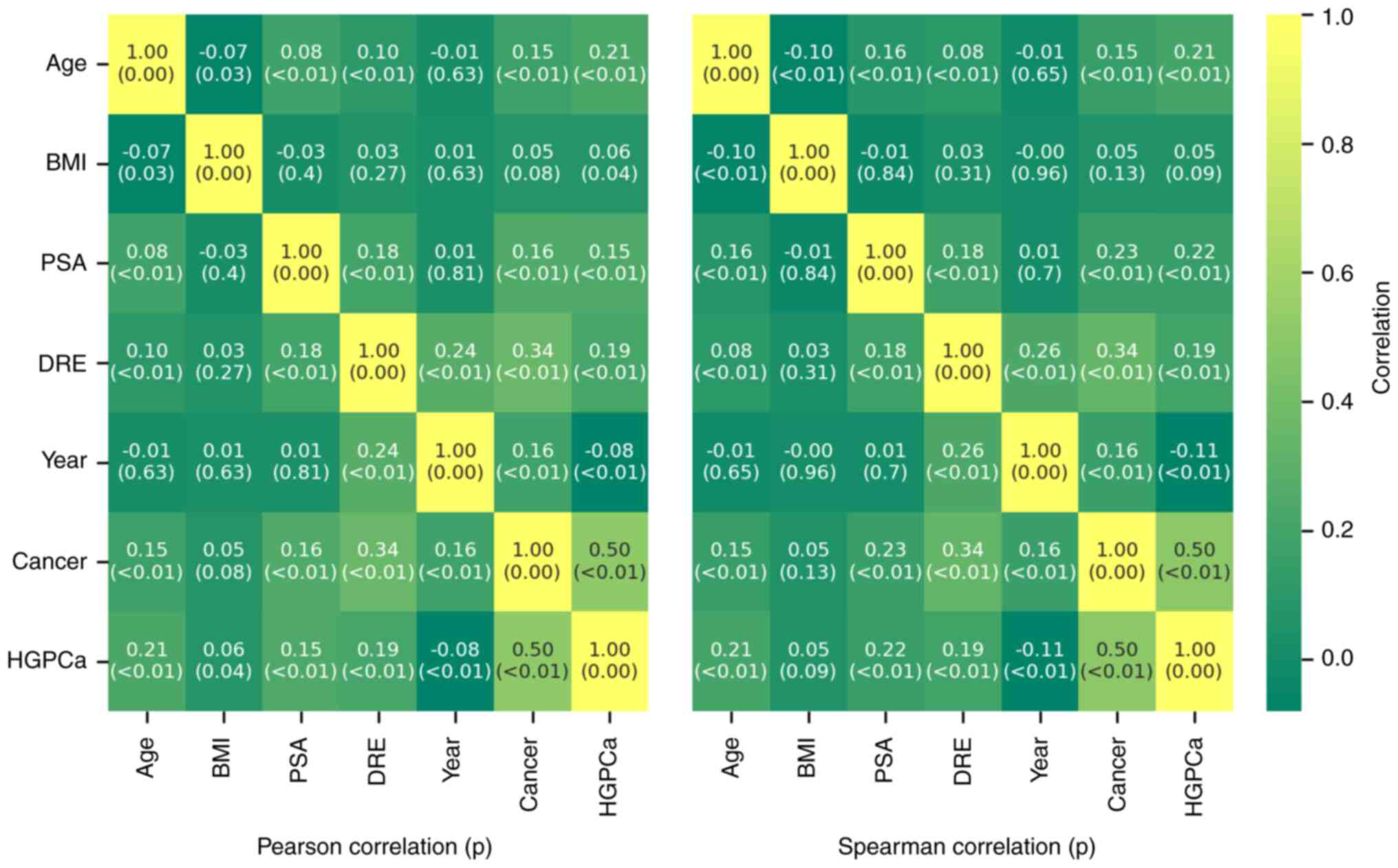|
1
|
Bell KJ, Del Mar C, Wright G, Dickinson J
and Glasziou P: Prevalence of incidental prostate cancer: A
systematic review of autopsy studies. Int J Cancer. 137:1749–1757.
2015.PubMed/NCBI View Article : Google Scholar
|
|
2
|
Ferlay J, Soerjomataram I, Dikshit R, Eser
S, Mathers C, Rebelo M, Parkin DM, Forman D and Bray F: Cancer
incidence and mortality worldwide: Sources, methods and major
patterns in GLOBOCAN 2012. Int J Cancer. 136:E359–E386.
2015.PubMed/NCBI View Article : Google Scholar
|
|
3
|
Haas GP, Delongchamps N, Brawley OW, Wang
CY and de la Roza G: The worldwide epidemiology of prostate cancer:
Perspectives from autopsy studies. Can J Urol. 15:3866–3871.
2008.PubMed/NCBI
|
|
4
|
Jansson KF, Akre O, Garmo H, Bill-Axelson
A, Adolfsson J, Stattin P and Bratt O: Concordance of tumor
differentiation among brothers with prostate cancer. Eur Urol.
62:656–561. 2012.PubMed/NCBI View Article : Google Scholar
|
|
5
|
Hemminki K: Familial risk and familial
survival in prostate cancer. World J Urol. 30:143–148.
2012.PubMed/NCBI View Article : Google Scholar
|
|
6
|
Randazzo M, Müller A, Carlsson S, Eberli
D, Huber A, Grobholz R, Manka L, Mortezavi A, Sulser T, Recker F
and Kwiatkowski M: A positive family history as a risk factor for
prostate cancer in a population-based study with organised
prostate-specific antigen screening: Results of the Swiss European
randomised study of screening for prostate cancer (ERSPC, Aarau).
BJU Int. 117:576–583. 2016.PubMed/NCBI View Article : Google Scholar
|
|
7
|
Tan DS, Mok TS and Rebbeck TR: Cancer
genomics: Diversity and disparity across ethnicity and geography. J
Clin Oncol. 34:91–101. 2016.PubMed/NCBI View Article : Google Scholar
|
|
8
|
Eeles RA, Olama AA, Benlloch S, Saunders
EJ, Leongamornlert DA, Tymrakiewicz M, Ghoussaini M, Luccarini C,
Dennis J, Jugurnauth-Little S, et al: Identification of 23 new
prostate cancer susceptibility loci using the iCOGS custom
genotyping array. Nat Genet. 45:385–391, 391e1-e2. 2013.PubMed/NCBI View
Article : Google Scholar
|
|
9
|
Amin Al Olama A, Dadaev T, Hazelett DJ, Li
Q, Leongamornlert D, Saunders EJ, Stephens S, Cieza-Borrella C,
Whitmore I, Benlloch Garcia S, et al: Multiple novel prostate
cancer susceptibility signals identified by fine-mapping of known
risk loci among Europeans. Hum Mol Genet. 24:5589–5602.
2015.PubMed/NCBI View Article : Google Scholar
|
|
10
|
Pritchard CC, Mateo J, Walsh MF, De Sarkar
N, Abida W, Beltran H, Garofalo A, Gulati R, Carreira S, Eeles R,
et al: Inherited DNA-repair gene mutations in men with metastatic
prostate cancer. N Engl J Med. 375:443–453. 2016.PubMed/NCBI View Article : Google Scholar
|
|
11
|
Lynch HT, Kosoko-Lasaki O, Leslie SW,
Rendell M, Shaw T, Snyder C, D'Amico AV, Buxbaum S, Isaacs WB, Loeb
S, et al: Screening for familial and hereditary prostate cancer.
Int J Cancer. 138:2579–2591. 2016.PubMed/NCBI View Article : Google Scholar
|
|
12
|
Ewing CM, Ray AM, Lange EM, Zuhlke KA,
Robbins CM, Tembe WD, Wiley KE, Isaacs SD, Johng D, Wang Y, et al:
Germline mutations in HOXB13 and prostate-cancer risk. N Engl J
Med. 366:141–149. 2012.PubMed/NCBI View Article : Google Scholar
|
|
13
|
Leitzmann MF and Rohrmann S: Risk factors
for the onset of prostatic cancer: Age, location, and behavioral
correlates. Clin Epidemiol. 4:1–11. 2012.PubMed/NCBI View Article : Google Scholar
|
|
14
|
Breslow N, Chan CW, Dhom G, Drury RA,
Franks LM, Gellei B, Lee YS, Lundberg S, Sparke B, Sternby NH and
Tulinius H: Latent carcinoma of prostate at autopsy in seven areas.
The international agency for research on cancer, Lyons, France. Int
J Cancer. 20:680–688. 1977.PubMed/NCBI View Article : Google Scholar
|
|
15
|
Global Health Risks: Mortality and burden
of disease attributable to selected major risks. World Health
Organisation: Geneva, Switzerland, 2019.
|
|
16
|
Kaaks R and Kühn T: Epidemiology: Obesity
and cancer-the evidence is fattening up. Nat Rev Endocrinol.
10:644–645. 2014.PubMed/NCBI View Article : Google Scholar
|
|
17
|
Bhaskaran K, Douglas I, Forbes H,
dos-Santos-Silva I, Leon DA and Smeeth L: Body-mass index and risk
of 22 specific cancers: A population-based cohort study of 5·24
million UK adults. Lancet. 384:755–765. 2014.PubMed/NCBI View Article : Google Scholar
|
|
18
|
American Cancer Society: Cancer facts and
figures. American Cancer Society: Atlanta, GA, USA, 2012.
|
|
19
|
Buschemeyer WC III and Freedland SJ:
Obesity and prostate cancer: Epidemiology and clinical
implications. Eur Urol. 52:331–343. 2007.PubMed/NCBI View Article : Google Scholar
|
|
20
|
Culp S and Porter M: The effect of obesity
and lower serum prostate-specific antigen levels on prostate-cancer
screening results in American men. BJU Int. 104:1457–1461.
2009.PubMed/NCBI View Article : Google Scholar
|
|
21
|
Baillargeon J, Pollock BH, Kristal AR,
Bradshaw P, Hernandez J, Basler J, Higgins B, Lynch S, Rozanski T,
Troyer D and Thompson I: The association of body mass index and
prostate-specific antigen in a population-based study. Cancer.
103:1092–1095. 2005.PubMed/NCBI View Article : Google Scholar
|
|
22
|
Freedland SJ, Terris MK, Platz EA and
Presti JC Jr: Body mass index as a predictor of prostate cancer:
Development versus detection on biopsy. Urology. 66:108–113.
2005.PubMed/NCBI View Article : Google Scholar
|
|
23
|
Fowke JH, Signorello LB, Chang SS,
Matthews CE, Buchowski MS, Cookson MS, Ukoli FM and Blot WJ:
Effects of obesity and height on prostate-specific antigen (PSA)
and percentage of free PSA levels among African-American and
Caucasian men. Cancer. 107:2361–2367. 2006.PubMed/NCBI View Article : Google Scholar
|
|
24
|
Beebe-Dimmer JL, Faerber GJ, Morgenstern
H, Werny D, Wojno K, Halstead-Nussloch B and Cooney KA: Body
composition and serum prostate-specific antigen: Review and
findings from Flint men's health study. Urology. 71:554–560.
2008.PubMed/NCBI View Article : Google Scholar
|
|
25
|
Rundle A and Neugut AI: Obesity and
screening PSA levels among men undergoing an annual physical exam.
Prostate. 68:373–380. 2008.PubMed/NCBI View Article : Google Scholar
|
|
26
|
Grubb RL III, Black A, Izmirlian G, Hickey
TP, Pinsky PF, Mabie JE, Riley TL, Ragard LR, Prorok PC, Berg CD,
et al: Serum prostate-specific antigen hemodilution among obese men
undergoing screening in the prostate, lung, colorectal, and ovarian
cancer screening trial. Cancer Epidemiol Biomarkers Prev.
18:748–751. 2009.PubMed/NCBI View Article : Google Scholar
|
|
27
|
Barqawi AB, Golden BK, O'Donnell C, Brawer
MK and Crawford ED: Observed effect of age and body mass index on
total and complexed PSA: Analysis from a national screening
program. Urology. 65:708–712. 2005.PubMed/NCBI View Article : Google Scholar
|
|
28
|
Price MM, Hamilton RJ, Robertson CN, Butts
MC and Freedland SJ: Body mass index, prostate-specific antigen,
and digital rectal examination findings among participants in a
prostate cancer screening clinic. Urology. 71:787–791.
2008.PubMed/NCBI View Article : Google Scholar
|
|
29
|
Bañez LL, Hamilton RJ, Partin AW, Vollmer
RT, Sun L, Rodriguez C, Wang Y, Terris MK, Aronson WJ, Presti JC
Jr, et al: Obesity-related plasma hemodilution and PSA
concentration among men with prostate cancer. JAMA. 298:2275–2280.
2007.PubMed/NCBI View Article : Google Scholar
|
|
30
|
Fontaine KR, Heo M and Allison DB: Obesity
and prostate cancer screening in the USA. Public Health.
119:694–698. 2005.PubMed/NCBI View Article : Google Scholar
|
|
31
|
Fowke JH, Signorello LB, Underwood W III,
Ukoli FA and Blot WJ: Obesity and prostate cancer screening among
African-American and Caucasian men. Prostate. 66:1371–1380.
2006.PubMed/NCBI View Article : Google Scholar
|
|
32
|
Scales CD Jr, Curtis LH, Norris RD,
Schulman KA, Dahm P and Moul JW: Relationship between body mass
index and prostate cancer screening in the United States. J Urol.
177:493–498. 2007.PubMed/NCBI View Article : Google Scholar
|
|
33
|
Engeland A, Tretli S and Bjørge T: Height,
body mass index, and prostate cancer: A follow-up of 950000
Norwegian men. Br J Cancer. 89:1237–1242. 2003.PubMed/NCBI View Article : Google Scholar
|
|
34
|
Andersson SO, Wolk A, Bergström R, Adami
HO, Engholm G, Englund A and Nyrén O: Body size and prostate
cancer: A 20-year follow-up study among 135006 Swedish construction
workers. J Natl Cancer Inst. 89:385–389. 1997.PubMed/NCBI View Article : Google Scholar
|
|
35
|
Jemal A, Bray F, Center MM, Ferlay J, Ward
E and Forman D: Global cancer statistics. CA Cancer J Clin.
61:69–90. 2011.PubMed/NCBI View Article : Google Scholar
|
|
36
|
Freedland SJ, Bañez LL, Sun LL, Fitzsimons
NJ and Moul JW: Obese men have higher-grade and larger tumors: An
analysis of the duke prostate center database. Prostate Cancer
Prostatic Dis. 12:259–263. 2009.PubMed/NCBI View Article : Google Scholar
|
|
37
|
Hu MB, Xu H, Bai PD, Jiang HW and Ding Q:
Obesity has multifaceted impact on biochemical recurrence of
prostate cancer: A dose-response meta-analysis of 36,927 patients.
Med Oncol. 31(829)2014.PubMed/NCBI View Article : Google Scholar
|
|
38
|
Hutterer G, Perrotte P, Gallina A, Walz J,
Jeldres C, Traumann M, Suardi N, Saad F, Bénard F, Valiquette L, et
al: Body mass index does not predict prostate-specific antigen or
percent free prostate-specific antigen in men undergoing prostate
cancer screening. Eur J Cancer. 43:1180–1187. 2007.PubMed/NCBI View Article : Google Scholar
|
|
39
|
Capitanio U, Perrotte P, Hutterer GC,
Suardi N, Jeldres C, Shariat SF, Duclos A, Arjane P, Montorsi F and
Karakiewicz PI: Effect of body mass index on prostate-specific
antigen and percentage free prostate-specific antigen: Results from
a prostate cancer screening cohort of 1490 men. Int J Urol.
16:91–95. 2009.PubMed/NCBI View Article : Google Scholar
|
|
40
|
Freedland SJ, Platz EA, Presti JC Jr,
Aronson WJ, Amling CL, Kane CJ and Terris MK: Obesity, serum
prostate specific antigen and prostate size: Implications for
prostate cancer detection. J Urol. 175:500–504. 2006.PubMed/NCBI View Article : Google Scholar
|
|
41
|
Hu MB, Liu SH, Jiang HW, Bai PD and Ding
Q: Obesity affects the biopsy-mediated detection of prostate
cancer, particularly high-grade prostate cancer: A dose-response
meta-analysis of 29,464 Patients. PLoS One.
9(e106677)2014.PubMed/NCBI View Article : Google Scholar
|
|
42
|
MacInnis RJ and English DR: Body size and
composition and prostate cancer risk: Systematic review and
meta-regression analysis. Cancer Causes Control. 17:989–1003.
2006.PubMed/NCBI View Article : Google Scholar
|
|
43
|
Kobayashi T, Mitsumori K, Nishizawa K,
Kawahara T, Ogura K and Ide Y: Association between body mass index
and prostate cancer detection rates in Japanese urologic patients.
Urology. 66:130–134. 2005.PubMed/NCBI View Article : Google Scholar
|
|
44
|
Masuda H, Kagawa M, Kawakami S, Numao N,
Matsuoka Y, Yokoyama M, Yamamoto S, Yonese J, Fukui I and Kihara K:
Body mass index influences prostate cancer risk at biopsy in
Japanese men. Int J Urol. 20:701–707. 2013.PubMed/NCBI View Article : Google Scholar
|
|
45
|
Park J, Cho SY, Lee SB, Son H and Jeong H:
Obesity is associated with higher risk of prostate cancer detection
in a biopsy population in Korea. BJU Int. 114:891–895.
2014.PubMed/NCBI View Article : Google Scholar
|
|
46
|
Lee SE, Hong SK, Park HZ, Chang JS, Yoon
CY, Byun SS and Abdullajanov M: Higher body mass index is
associated with lower risk of prostate cancer detection via multi
(≥12)-core prostate biopsy in Korean men. Urology. 76:1063–1066.
2010.PubMed/NCBI View Article : Google Scholar
|
|
47
|
Oh JJ, Jeong SJ, Lee BK, Jeong CW, Byun
SS, Hong SK and Lee SE: Does obesity affect the accuracy of
prostate-specific antigen (PSA) for predicting prostate cancer
among men undergoing prostate biopsy. BJU Int. 112:E265–E271.
2013.PubMed/NCBI View Article : Google Scholar
|
|
48
|
Lavalette C, Cordina Duverger E, Artaud F,
Rébillard X, Lamy PJ, Trétarre B, Cénée S and Menegaux F: Body mass
index trajectories and prostate cancer risk: Results from the
EPICAP study. Cancer Med. 9:6421–6429. 2020.PubMed/NCBI View Article : Google Scholar
|
|
49
|
Michael J, Oyekunle T, Howard L, De Hoedt
A, Hoyo C, Grant D and Freedland S: Interplay between exercise and
BMI; results from an equal access, racially diverse biopsy study.
Cancer Causes Control. 30:13–20. 2019.PubMed/NCBI View Article : Google Scholar
|
|
50
|
Werny DM, Thompson T, Saraiya M, Freedman
D, Kottiri BJ, German RR and Wener M: Obesity is negatively
associated with prostate-specific antigen in U.S. men, 2001-2004.
Cancer Epidemiol Biomarkers Prev. 16:70–76. 2007.PubMed/NCBI View Article : Google Scholar
|
|
51
|
Kim YJ, Han BK, Hong SK, Byun SS, Kim WJ
and Lee SE: Body mass index influences prostate-specific antigen in
men younger than 60 years of age. Int J Urol. 14:1009–1012.
2007.PubMed/NCBI View Article : Google Scholar
|
|
52
|
Isom-Batz G, Bianco FJ Jr, Kattan MW,
Mulhall JP, Lilja H and Eastham JA: Testosterone as a predictor of
pathological stage in clinically localized prostate cancer. J Urol.
173:1935–1937. 2005.PubMed/NCBI View Article : Google Scholar
|
|
53
|
Nwadi UV, Nwofor AME, Oranusi CK, Orakwe
JC, Obiesie EA, Mbaeri TU, Abiahu JA and Mbonu OO: Correlation
between body mass index and gleason score in men with prostate
cancer in Southeastern Nigeria. Niger J Surg. 27:22–27.
2021.PubMed/NCBI View Article : Google Scholar
|
|
54
|
Price RS, Cavazos DA, De Angel RE,
Hursting SD and deGraffenried LA: Obesity-related systemic factors
promote an invasive phenotype in prostate cancer cells. Prostate
Cancer Prostatic Dis. 15:135–143. 2012.PubMed/NCBI View Article : Google Scholar
|
|
55
|
Nandeesha H: Insulin: A novel agent in the
pathogenesis of prostate cancer. Int Urol Nephrol. 41:267–272.
2009.PubMed/NCBI View Article : Google Scholar
|
|
56
|
Fowke JH, Motley SS, Cookson MS,
Concepcion R, Chang SS, Wills ML and Smith JA Jr: The association
between body size, prostate volume and prostate-specific antigen.
Prostate Cancer Prostatic Dis. 10:137–142. 2007.PubMed/NCBI View Article : Google Scholar
|
|
57
|
Park JH, Cho BL, Kwon HT, Lee CM and Han
HJ: Effect of body mass index and waist circumference on prostate
specific antigen and prostate volume in a generally healthy Korean
population. J Urol. 182:106–111. 2009.PubMed/NCBI View Article : Google Scholar
|
|
58
|
Yang CY, Peng CY, Liu YC, Chen WZ and
Chiou WK: Surface anthropometric indices in obesity-related
metabolic diseases and cancers. Chang Gung Med J. 34:1–22.
2011.PubMed/NCBI
|
|
59
|
Qu YY, Dai B, Kong YY, Chang K, Ye DW, Yao
XD, Zhang SL, Zhang HL and Yang WY: Influence of obesity on
localized prostate cancer patients treated with radical
prostatectomy. Asian J Androl. 15:747–752. 2013.PubMed/NCBI View Article : Google Scholar
|
|
60
|
Choi JB, Myong JP, Lee Y, Kim I, Kim JH,
Hong SH and Ha US: Does increased body mass index lead to elevated
prostate cancer risk? It depends on waist circumference. BMC
Cancer. 20(589)2020.PubMed/NCBI View Article : Google Scholar
|

















